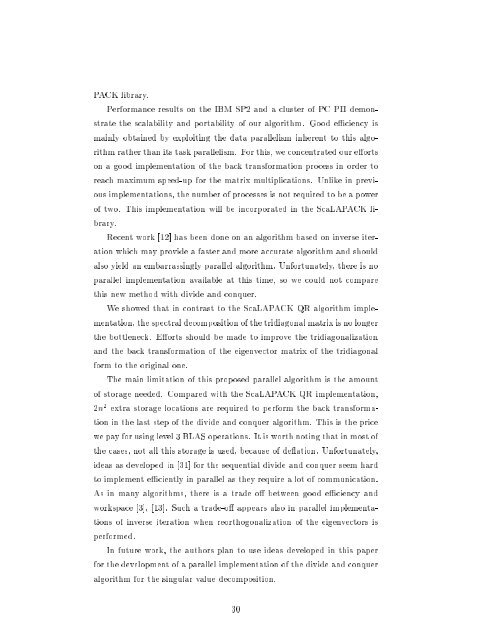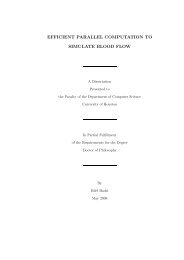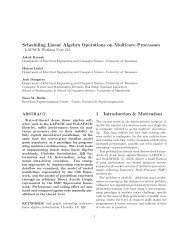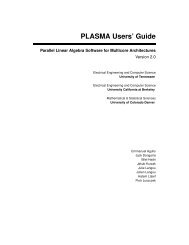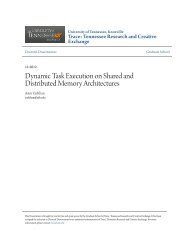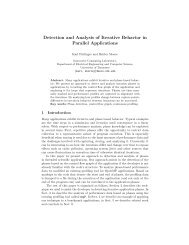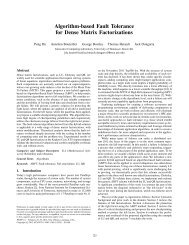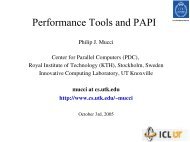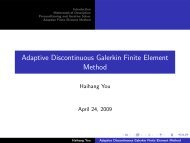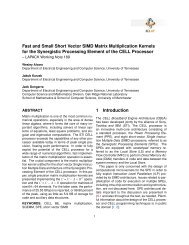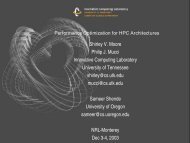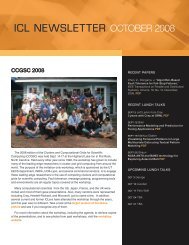Parallelizing the Divide and Conquer Algorithm - Innovative ...
Parallelizing the Divide and Conquer Algorithm - Innovative ...
Parallelizing the Divide and Conquer Algorithm - Innovative ...
You also want an ePaper? Increase the reach of your titles
YUMPU automatically turns print PDFs into web optimized ePapers that Google loves.
PACK library.<br />
Performance results on <strong>the</strong> IBM SP2 <strong>and</strong> a cluster of PC PII demonstrate<br />
<strong>the</strong> scalability <strong>and</strong> portability of our algorithm. Good eciency is<br />
mainly obtained by exploiting <strong>the</strong> data parallelism inherent to this algorithm<br />
ra<strong>the</strong>r than its task parallelism. For this, we concentrated our eorts<br />
on a good implementation of <strong>the</strong> back transformation process in order to<br />
reach maximum speed-up for <strong>the</strong> matrix multiplications. Unlike in previous<br />
implementations, <strong>the</strong> number of processes is not required to be a power<br />
of two. This implementation will be incorporated in <strong>the</strong> ScaLAPACK library.<br />
Recent work [12] has been done on an algorithm based on inverse iteration<br />
which may provide a faster <strong>and</strong> more accurate algorithm <strong>and</strong> should<br />
also yield an embarrassingly parallel algorithm. Unfortunately, <strong>the</strong>re is no<br />
parallel implementation available at this time, so we could not compare<br />
this new method with divide <strong>and</strong> conquer.<br />
We showed that in contrast to <strong>the</strong> ScaLAPACK QR algorithm implementation,<br />
<strong>the</strong> spectral decomposition of <strong>the</strong> tridiagonal matrix is no longer<br />
<strong>the</strong> bottleneck. Eorts should be made to improve <strong>the</strong> tridiagonalization<br />
<strong>and</strong> <strong>the</strong> back transformation of <strong>the</strong> eigenvector matrix of <strong>the</strong> tridiagonal<br />
form to <strong>the</strong> original one.<br />
The main limitation of this proposed parallel algorithm is <strong>the</strong> amount<br />
of storage needed. Compared with <strong>the</strong> ScaLAPACK QR implementation,<br />
2n 2 extra storage locations are required to perform <strong>the</strong> back transformation<br />
in <strong>the</strong> last step of <strong>the</strong> divide <strong>and</strong> conquer algorithm. This is <strong>the</strong> price<br />
we pay for using level 3 BLAS operations. It is worth noting that in most of<br />
<strong>the</strong> cases, not all this storage is used, because of deation. Unfortunately,<br />
ideas as developed in [31] for <strong>the</strong> sequential divide <strong>and</strong> conquer seem hard<br />
to implement eciently in parallel as <strong>the</strong>y require a lot of communication.<br />
As in many algorithms, <strong>the</strong>re is a trade o between good eciency <strong>and</strong><br />
workspace [3], [13]. Such a trade-o appears also in parallel implementations<br />
of inverse iteration when reorthogonalization of <strong>the</strong> eigenvectors is<br />
performed.<br />
In future work, <strong>the</strong> authors plan to use ideas developed in this paper<br />
for <strong>the</strong> development of a parallel implementation of <strong>the</strong> divide <strong>and</strong> conquer<br />
algorithm for <strong>the</strong> singular value decomposition.<br />
30


